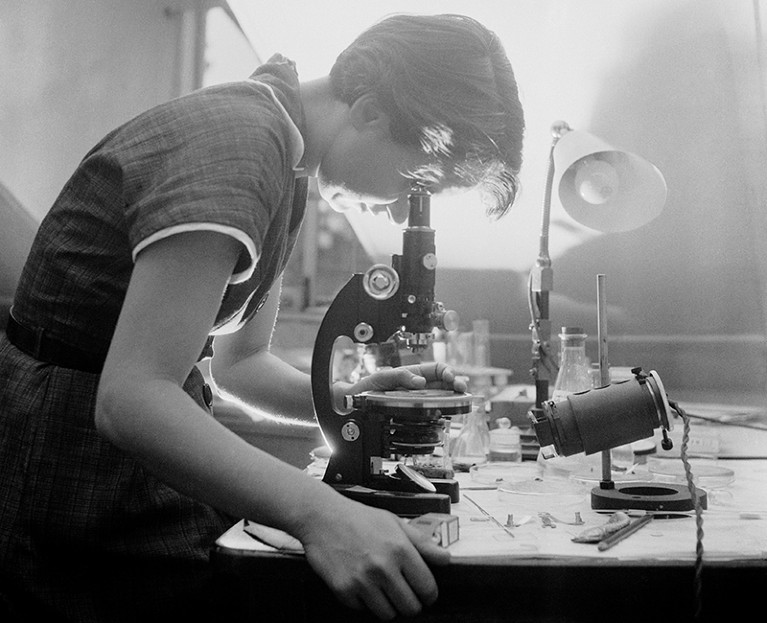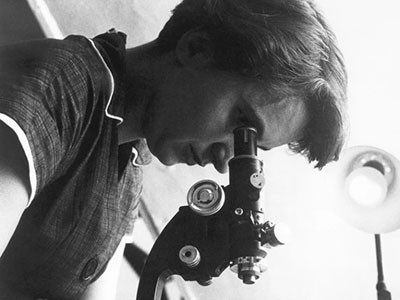
Rosalind Franklin’s colleagues refused to recognize her strengths because of who she was.Credit: Henry Grant Collection/Mol/Shutterstock
Seventy years on from the discovery of the structure of DNA, controversy still surrounds two central points: how much credit Rosalind Franklin deserved, and the degree to which she was denied it. A lot of what we know about Franklin’s contribution comes from other people. Initially these were Franklin’s main collaborators: her colleague at King’s College London, biophysicist Maurice Wilkins, and molecular biologists Francis Crick and James Watson at the University of Cambridge, UK. Each wrote autobiographical accounts and gave interviews to journalists and researchers. Franklin, a physical chemist, left no comparable account: she died from ovarian cancer in 1958 at the age of 37.
Franklin’s perspective in her own published words has always been missing from the story that led to the inclusion of three papers1–3 in Nature in 1953. In this issue, zoologist Matthew Cobb and medical historian Nathaniel Comfort (who are writing separate biographies of Crick and Watson) reconstruct the development of Franklin’s ideas using her papers, archived at Churchill College, University of Cambridge.
What Rosalind Franklin truly contributed to the discovery of DNA’s structure
One clear conclusion is that the untangling pf DNA’s structure was a team effort. Crick and Watson were the theoreticians and model builders — literally, using cardboard cut-outs to illustrate possible structures. But they could not have arrived at the right structure without experimental input: X-ray diffraction data from Franklin, Wilkins and Franklin’s student Raymond Gosling.
Besides this confluence of theory and experiment — which Watson and Crick did not acknowledge in their original paper — management support was essential to the project’s success. Senior academics at both universities were very involved, partly because they wanted to get to the structure before US chemist Linus Pauling did.
But if the discovery was a true joint effort, at least one member of the team, Franklin, was also very much on the outside. She was excluded from the networks of men who continuously shared data and insights. There were frequent clashes and the evidence of sexism is clear in Watson’s 1968 account The Double Helix in which he wrote: “Clearly Rosy [sic] had to go or be put in her place.”
Journalist Brenda Maddox, who drew on Franklin’s personal correspondence for her 2003 biography Rosalind Franklin, makes a further important point. Franklin was Jewish and unhappy in a broader atmosphere of antisemitism at King’s College London at the time: leaving was more important to her than completing the work on DNA. Crystallographer J. D. Bernal observed in his obituary of Franklin that she was an enthusiastic collaborator and mentor, and happier at Birkbeck College in London than King’s, leading a team that worked on the tobacco mosaic virus.
Rosalind Franklin was so much more than the ‘wronged heroine’ of DNA
Franklin eventually reconciled with Crick and Watson. And Cobb and Comfort point out that, in a 1954 paper, the two men acknowledge that their structure “would have been most unlikely, if not impossible”, without Franklin’s data4. Assigning due credit is an indication of collaboration, and it’s an injustice when this happens only after the event.
The broader point is that Franklin’s colleagues — and the scientific environment they moved in — refused to recognize her strengths, purely because of who she was. Sadly, that remains the case: the title of a paper published in Nature last year5, “Women are credited less in science than men”, says it all. Diversity, equity and inclusion are concepts that some still regard as fashionable impositions and anathema to ‘good’ science. The DNA story shows that they are the foundations of beneficial collaboration and scientific progress.

 What Rosalind Franklin truly contributed to the discovery of DNA’s structure
What Rosalind Franklin truly contributed to the discovery of DNA’s structure
 Rosalind Franklin was so much more than the ‘wronged heroine’ of DNA
Rosalind Franklin was so much more than the ‘wronged heroine’ of DNA
 The double helix and the ‘wronged heroine’
The double helix and the ‘wronged heroine’
 Francis Crick (1916–2004)
Francis Crick (1916–2004)
 Maurice Wilkins (1916–2004)
Maurice Wilkins (1916–2004)








